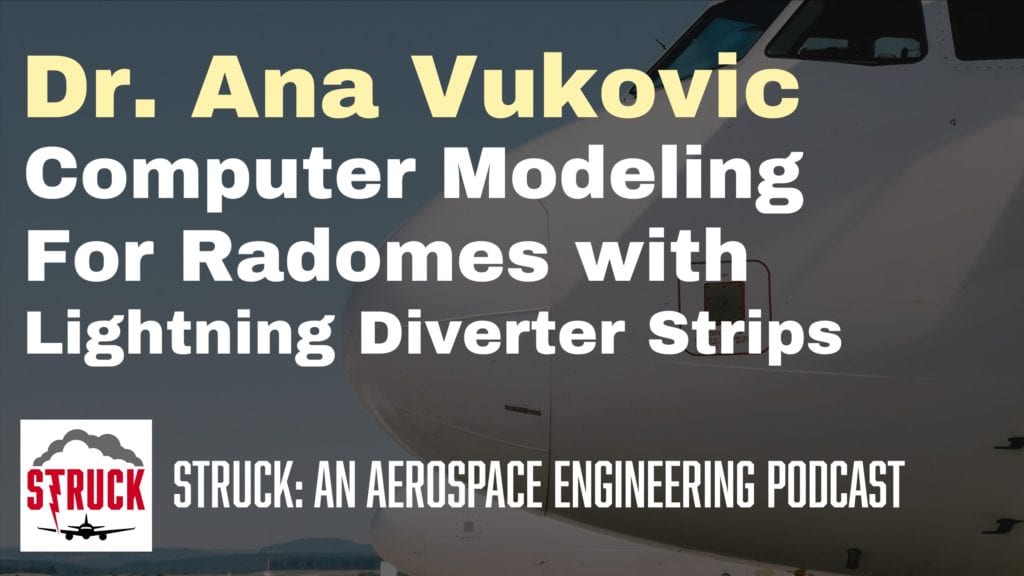Dr. Ana Vukovic joined us to talk about radome design testing using her computer modeling techniques at the University of Nottingham’s George Green Institute for Electromagnetics Research lab. Testing radomes complete with lightning diverter strips is a game-changer. Watch the video version of this episode on YouTube.
Her team can test radomes complete with lightning diverter strips to get accurate modeling before physical parts are created. Her team at the University of Nottingham, including Dr. Trevor Benson (trevor.benson@nottingham.ac.uk) and Dr. Phillip Sewell (phillip.sewell@nottingham.ac.uk), are doing incredible work to push the limits of computational modeling in the aerospace and other industries. Contact Dr. Ana Vukovic at ana.vukovic@nottingham.ac.uk or visit the University of Nottingham at https://www.nottingham.ac.uk/research/groups/ggiemr/index.aspx
Podcast: Play in new window | Download
Transcript – Dr. Ana Vukovic on Computer Modeling for Radome Design Testing with Lightning Diverter Strips
Dan: And here on struck, we talk about everything. Aviation, aerospace engineering, and lightning protection. All right, welcome back. We’ve got another great episode of struck actually a special episode today.
so Allen, we’ve got another, really good segment with Dr. Ana Vukovich out of the George Green, Center for Electromagnetics Research out of the University of Nottingham. And, what are we, what are we talking about today?
Allen Hall: We’re talking about a paper that is being published this summer. That. They at the University of Nottingham had put together, which looks like the performance of radar homes installed sort of on aircraft with the lightning protection on the radar.
And so usually when we model, we’re just looking at the, our performance of itself of the radar, basically the thickness and the dielectric constant of the radar and whatever the antenna is behind it. That’s basically the basics of trying to get an antenna pattern out of that. Cause you can model the antenna and you can model the radon and then you can kind of combine the two together to simulate.
What that would look like RF wise, the real key to the University of Nottingham’s approach is that they can actually install lightning protection on the radar, which is the next level up, because the RF performance of the radar is not just, or the radar itself, but everything else that’s on it, including paint coatings and diverted strips and whatever else is going to be on the radar, erosion boots, things of that sort.
That’s been very difficult to model in the past, but Nottingham has broken through that barrier. And is able to not only simulate, the effects of diverted stress, but like accurately do it. So their, their modeling has very F really, really capable meshing of small objects, but it also does larger object too.
So you can get to the fine detail, a diverter strip, like a segment, a diverter strip–like StrikeTape–on top of a larger radome, like on an Airbus A380 radome and get performance numbers, which is unheard of.
Dan: So this paper, Impact of In-situ Radome on Lighting Diverter Strips on Antenna Performance was written by dr. Ana Vukovic, Dr. Phillip Sewell and Dr. Trevor Benson. So I mean, a pretty impressive group. And what they’re doing with computer modeling is, is pretty special.
Allen Hall: It’s way off the charts special right now. And this is sort of your dream as an RF designer to have this kind of capability at your fingertips.
And. We really haven’t had that much power to do things like this without having essentially a supercomputer now, because of the way that a Nottingham is broken up their mesh and able to handle some of those more discrete problems. Now we have the capability of actually modeling an antenna and a radar come in in an aircraft without having all the pieces there.
So we don’t have to build it and test it. We just model it, try it. And if you don’t like it, adjust it. And that’s the way it should be. So big improvement on, reducing costs and producibility issues and all those other things that come with making aircraft parts are going to be greatly impacted by this paper.
Dan: Well, yeah, I mean, especially in today’s, you know, not just economic condition, but you know, with COVID-19 with all of this stuff, being able to test things in a, in a lab in a day, instead of having to build physical parts and put them on a plane and get people in it and gas it up and go, I mean, it seems like just a huge, yeah.

A huge time and cost savings and just logistical savings with just everything that’s been going on in the world. So I think the timing for it as well,
Allen Hall: it’s great timing. And there’s a small cottage industry of in the aircraft world of testing RF testing of nose rate homes, which is where this papers is discussing in particular.
There’s, there are a limited number of sites around the world in which they have an antenna range and those incinerators are expensive millions of dollars. And to actually get time on them. Is not easy either. So you have to actually make the part, shift the part to the lab, get it up on the range, test it, tweak it, tweak it.
It’s like this iterative process, which is expensive as all get out. And now we can do that computationally for much less cost. And thank goodness. We’re finally get to the point of doing this
Dan: well, We’re going to jump to the segment with Dr. Ana Vukovic on the Impact of In-situ Radome Lightning Diverter Strips on Antenna Performance.
Allen Hall: So Ana, one of the more complex problems there are in the world today is trying to model antennas, under radomes. And you recently published a paper, discussing how your modeling can produce very accurate results, of, radon and antenna, and even including lightning protection on the radome. Can you explain how that all works?
Dr. Ana Vukovic: So we know that lightning protection is critical for usually lightning protection is placed on the nose of the random where of the, which is the most sensitive region, for the lightning strike. However, this, well, what we don’t know is how disliking protection, which is metallic will affect the antenna. And we know that any metallic structures when it’s put into near field of antenna, well, Somehow affect the antenna performance.
So previously we have just the model impact the radome, simple, random with no protection on antenna. And, in this next step, we are now including diverters on the on the radome nose, metallic or segmented diverters Allen–like you–like you invented a and prototype. So, in fact, I was looking at you prototype on Google, to, find out some dimensions.
So, so yeah, so we have, for example, I think, our overall rate them diameter was one meter. and segmented diverter strips had five millimeter radius. We had a very complicated antenna, which has evolved the antenna at the bottom, which we, which operated the three gigahertz. so all this, was, the subject.
So the paper, how the debate, the strips affect the performance of antenna.
Allen Hall: you actually did, as you did a comparison between no lightning protection, which older aircraft still implement, to metal bar or what we call hard bars, sometimes just metal bars, which you see on a, like an Airbus or A320 or a Boeing 737.
And then to the segmented diverters, which you see on more modern aircraft, you saw differences between those three configurations in terms of the RF pattern. Can you explain that a little bit?
Dr. Ana Vukovic: We saw differences and, initially, we looked at sec, so metallic strip is just simple metallic. or a certain thickness of certain week, however, segmented at the strips have, different parameters, spacing between metallic segments, size of the segments or length of the segments and so on.
So what we observed is as you reduce the spacing between metallic segments, they, the, the likely protection becomes more visible to antenna and interferes with antenna pattern more. Before I was writing the paper before I brought the paper, I did lots of research on what other people have found out.
And predominantly people were reporting that segmented diverter strips have no effects that metallic, metallic, metallic, diverters have some but meant it not, unless there is a lightning channel. Now what we find is that again, it depends on the structure of lightning diverter strip–segmented, diverter strip. Some, diverter strips with gaps between six segments of a much bigger, and bigger, meaning more than one millimeter, bigger.
are more invisible to antennas. However, as you reduce this gap, 2.3 millimeters, which is what is in practice. If, if I’m, if I’m not wrong, then it becomes much more visible. It’s not a huge impact, but it’s more than nothing,
Allen Hall: Right. Yeah. As, as the, each of the metal segments gets closer together, they become sort of capacitively coupled together and then RF-wise, you can start to see them.
And that’s why we always encourage, customers to, we provide a lot of samples. Try the product out, see which one works. We do offer different varieties of button sizes and gap spacings so that it worked for their particular application. Now that the difficulty has been in modeling, that is because the segment of diverted structure is relatively small compared to the size of the radome.
So like a 737 radome is big it’s it’s, you know, meter plus diameter and a segmented diverter, the segments are very, very small. So you’ve been the really, the first group that I’ve ever seen, to do something really accurate computationally, even to get the antenna patterns, which you don’t see a lot of computationally with a radar home.
So you did the radome plus the lightning protection on it to really get accurate antenna patterns. That’s unusual because the industry right now spends a lot of money. And, millions of dollars of, on equipment and technology and parts to verify the performance of something you can do on a computer right now, which is unbelievable.
so how. How accurate do you think this model can get? is it just a matter of just knowing all the parameters here because you have the accuracy already to, to, to model it, or is it more technology needed going forward? What, what are your thoughts there?
Dr. Ana Vukovic: I think that the reason there aren’t any, so the reported results.
Because it’s very difficult to create geometry of lightning diverter strips on radome. The lightning diverter strip is designed in a flat, or the flat component and the radome is curved. So just simply using boolian geometry to attach, a diverter strip on a doubly curved surface is very difficult without creating small segments.
Now this is where we have our own angle we use, so there’s some, progress from computer graphics. Two more, divert is on the random surface. That is the first step that enabled us to consider, submitted the vector slips on the rate of surface. And then next step is meshing it efficiently and sort of clustering, small cells have come out, especially of that job from the joining of the diverter strips.
Allen Hall: Yeah. Yeah. The way even in terminates; I know one of the issues that a lot of our customers have on, on nose radomes is how things are grounded and where in particular, you know, you’re going to need a certain amount of diverter shows for lightening protection. Let’s just get that out there. The question is where do you put those diverter strips on the radome?
So you impact the RF performance the least, right? And right now there’s only really one way to do that is to physically go out and put the antenna and radome up on a, on an antenna range to do all the measurements. And there’s actually an RTCA document- RTCA-DO-213. Now I think it’s Rev. A, to do that.
So there’s actually a whole industry set up to go do that. You can do that now without, and this is, Dan, gets back to the, all the, sort of the hit and miss approach to how we design. Mm, anything in aerospace. So what we would normally do was just take some metal tape out, take the rate, home, run some antenna patterns, put it where we think the diverters ought to go and then say, yeah, no, move it here, move it there.
So it’s this real iterative process. What Ana’s talking about is she can model that. Now, and we can do it on a computer. We don’t actually have to build the article first. We can actually build, build it computationally.
Dan: So this is the pattern where you want them, how long you want them, all that stuff, right?
Allen Hall: Where do you want them? How long they are, where they want to be. And literally an inch or two, either direction on where you’re located. A verdict can have a big impact on RF performance and Ana’s paper shows that. Where you put the diverters matters.
Dr. Ana Vukovic: Yeah. And it also depends on, on the type of diverter.
If a diverter has bigger space in between segments, maybe you can put more diverters on for better protection because it interferes less with the antenna. We did look at all the older parameters, how the length, the spacing between the diverters spacing between metallic segments, we looked at the way they explore the whole range of parameters and we made some, I think quite different conclusions from what we found in literature today.
Allen Hall: Oh yeah. It’s, it’s definitely different now. Where can people find this paper? Where’s it going to be published at? I know we’re coming out of the COVID-19 so where we’re working, people find this paper.
Dr. Ana Vukovic: So this paper is coming in IEEE transactions antenna propagation, and is in print at the moment. So that’ll be next month or a month after. Very, very soon.
Dan: All right. Well, that’s it for our episode here today with Dr. Ana Vukovic. So if you want to follow up with her and her team, you can find them again at the George Green Center for Electromagnetics Research on the web.
And then obviously you can email her directly. So we’re going to put her contact information and a website links to her and her team in the show notes or in the description here on iTunes, Spotify, or YouTube, wherever you’re listening. And thanks again for being here on the Struck Podcast. And we’ll see you next time.
If you’re new to the show, thank you so much for listening. And please leave a review and subscribe on iTunes, Spotify, or wherever you listen to podcasts. Check out the weather guard, lightening tech YouTube channel for video episodes, full interviews and short clips from the show. And follow us on LinkedIn, Twitter, Instagram, and Facebook.
Our handle is @wglightning. Tune in next tuesday for another great episode on aviation, aerospace engineering and lightning protection.











